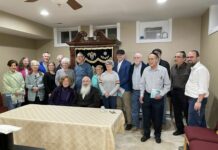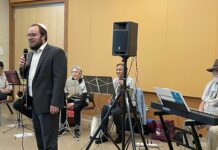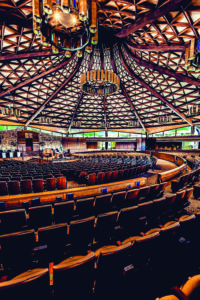
This High Holiday season is a promising time for Beth Tfiloh Congregation. This year, the 3,500-member synagogue, which says it is the largest Modern Orthodox synagogue in the country, is not only ushering in the Jewish New Year but a brand-new century. Beth Tfiloh, renowned for its groundbreaking approaches to Jewish education and, at times, to Orthodox worship, is turning 100.
To acknowledge the centennial, Beth Tfiloh plans to hold several celebratory events, including a Penn lecture in November, a Chanukah celebration and more. Since the synagogue was founded around the High Holidays in 1921, this season’s celebrations will serve as a venue for acknowledging the synagogue’s unique heritage.
Beth Tfiloh’s early years
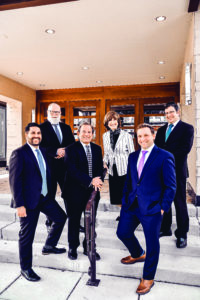
Like many of Baltimore’s earliest congregations, Beth Tfiloh has grown exponentially since its modest beginnings in the 1920s. The early founders who had fled Europe in search of a new and safer homeland had big plans for their new shul. They also wasted no time breaking ground. For the first year, congregants davened in living rooms until they could secure property for the new shul. By 1923, preparations for its first house of worship in Forest Park were underway, and by 1927, Beth Tfiloh had picked out their first rabbi, Rabbi Samuel Rosenblatt, who had dreams as big as their own.
“Rabbi Rosenblatt had the vision and insight to see this synagogue as being more than just a house of prayer, even though that is what Beth Tfiloh means,” said Rabbi Mitchell Wohlberg, who has served as Beth Tfiloh’s head rabbi since 1978.
The congregation’s name, Wohlberg said, hearkens back to the often-quoted verse in Isaiah, “For my temple shall be called a house of prayer for all peoples” (56:7).
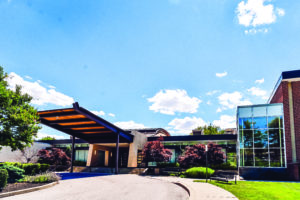
“[Rosenblatt] saw the house of prayer being open as a place of learning and a place of assembly, the other names that are associated with a synagogue,” Wohlberg said. After all, “How many synagogues in the ‘30s and ‘40s built a gymnasium? But Rabbi Rosenblatt had the foresight to know that if we want our kids to come to shul, we’ve got to make it worth their while.”
And the synagogue did. Rosenblatt instituted numerous programs, including a bat mitzvah program, designed to inspire young women to attend shul. By 1942, a Hebrew school and elementary-level day school were in place, offering a blend of religious and secular instruction.
“Just think what it was like to establish a day school in 1942,” Wohlberg said. “Jewish children were being burned in Europe.”
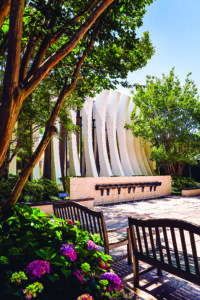
In Bratislava, Slovakia, Rosenblatt’s native town, thousands of Jews were deported and killed during the Holocaust. But in Baltimore, Beth Tfiloh was creating an educational home and house of worship that would grow into the next century.
Rosenblatt, who had been raised in a traditional German Orthodox home, and later obtained his ordination at the Conservative movement’s Jewish Theological Seminary, saw an opportunity and willingness by the membership to create a Hebrew school much like the German Talmud Torah “Realschule” that he had been exposed to in his homeland.
“Beth Tfiloh Day School reflected both Rosenblatt’s upbringing and the Orthodox and American milieu in which Beth Tfiloh Congregation existed,” writes Laura Shaw Frank, director of contemporary Jewish life at American Jewish Committee, in her paper, “A Day School for the Community: The Founding of Beth Tfiloh Day School in Baltimore” (Univ. of Maryland, 2008).
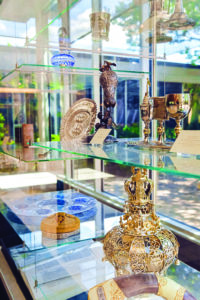
The new school, which eventually included a junior high school and a summer camp, also appealed to young families who wanted their children’s education to be steeped in both secular and Jewish education.
But by the late 1960s, Beth Tfiloh’s growth was beginning to wane. Congregants, in search of more affluent beginnings, were moving to the suburbs. As membership began to drop, Beth Tfiloh realized it would need to relocate as well.
The move to Pikesville not only brought opportunity for a new, modern synagogue, but rekindled old debates about its conventional seating arrangements. The topic of Beth Tfiloh’s mechitzah (a physical partition used in Orthodox synagogues to separate male and female seating) resurfaced, and this time the congregation’s more progressive members won out. When the new state-of-the-art sanctuary was designed by New York architect Morris Lapidus, the mechitzah was left off the blueprints. Beth Tfiloh reopened in 1966.
“[Many] people felt that the only way that Beth Tfiloh could survive was if they had mixed seating,” Wohlberg explained. “And [that] basically turned it Conservative. Rabbi Rosenblatt and obviously the majority did not agree. But what they did was, as sort of a compromise, they had separate seating without a mechitzah, which meant that nobody was happy.”
The change was temporary. In 2003, after the Orthodox Union announced that synagogues that did not have partitions would not be considered Orthodox, Wohlberg led a campaign to reinstitute the mechitzah. His compromise was anything but conventional.
The new partition was a stylish set of swinging cafe-style doors, made of metal adjoining the two sections. Designed in Israel, they were Beth Tfiloh’s answer to Judaism’s perennial debate over egalitarian seating.
“That was being Modern Orthodox,” Wohlberg explained. “This was not meant to be a barrier [and] it was not meant to block anyone out.”
It also wasn’t meant to demean women’s roles in the synagogue, he said, when he announced it to the congregation one Kol Nidre evening.
“We are a Modern Orthodox congregation, and we have to do something to make ourselves a bit more Orthodox,” he explained. “That was the mechitzah, and a bit more modern, and that was to empower women.”
As part of that new mandate, women could now carry the Torah in processions within their own seating section. They were also increasingly recognized for their rights and value in synagogue participation.
“Hard as it is to believe, but when I came to Beth Tfiloh, women were not members of the congregation. Only their husbands [were],” Wohlberg said. “And women did not participate in any which way. … When you had a bar mitzvah or a baby naming, it was as if the child did not have a mother. We changed all that.”
‘We practice healthy Judaism’
Wohlberg has also been instrumental in leading another revolution, one that he says his predecessor started when he opened the doors to Baltimore’s first co-educational day school. When asked what prompted him to accept the appointment of head rabbi in 1978, Wohlberg said it was Beth Tfiloh’s educational aspirations.
“The school was the attraction to me,” Wohlberg said. “That a synagogue should have its own day school was rather unique. It’s still unique.
“I happen to believe that the day schools are the key to the survival of American Jewry, and that more than all of the defense agencies and all of that, if we really want to see Jewish continuity and Jewish survival, Jewish connections to the state of Israel coming from American Jews, it’s going to come from day school students who receive the kind of education that they rightfully deserve as part of their heritage.”
To facilitate that goal, the synagogue hired Zipora Schorr in 1986 to oversee the Beth Tfiloh Community School. Wohlberg and Schorr worked together to launch a new high school that same year. The K-12 complex was later renamed the Beth Tfiloh Dahan Community School after Haron Dahan, who along with two other congregants, Morton Macks and Marvin Weiner, donated the funds to construct the new educational campus on Old Court Road in Pikesville.
Schorr said the school’s goal isn’t just to teach students the state-mandated curriculum or to get them into college with good grades, but to instill in them an appreciation of “derech eretz.”
“We are bookended by two important pillars — derech eretz, respect. We are all created in the image of God. I deserve your respect, you deserve mine. The other is simcha, joy. There are so many people being brought up with a sense of coercion in Judaism,” Schorr said. “I believe that Judaism is about joy. Understanding that we have a mission on this earth, and we should do it happily. When I pass a child who is not smiling, I want to know why. Without joy you cannot go forward. Without loving yourself, you cannot love God.”
Since Schorr’s appointment, Beth Tfiloh’s enrollment has jumped from 350 students to an average of almost 1,000 each year, crediting Beth Tfiloh with worldwide recognition. Her most recent awards include the (Maryland) Governor’s Citation and Outstanding Educator in the Diaspora by Michlelet Lifshitz of the Israel Ministry of Education (2012).
Education, Schorr said, shouldn’t be driven by one’s religious affiliation.
“I am not prepared to accept the fact that the only Jews who will be Jewishly educated are Orthodox Jews,” Schorr said. “I can’t accept that premise. If I am, I might as well stop what I’m doing. With a 70% intermarriage rate, I am more driven than ever before. … If anything, I’ve scaled up. The initiatives we’ve worked on throughout COVID will prove how creative we are and how focused we are on excellence.”
Wohlberg agrees.
“People ask me if the school practices Orthodox, Conservative or Reform Judaism,” Wohlberg said. “My response is, ‘We practice healthy Judaism.’ We give equal emphasis to science and religion, to Orthodox and non-Orthodox, to Israel and the United States. To male and female.”
This coming January will mark one more significant transition for Beth Tfiloh. As the synagogue moves into its second century, Wohlberg will pass the bima on to a new head rabbi, Rabbi Mordechai Posner, who has been with Beth Tfiloh since 2010. Wohlberg said he is looking forward to his new role as Beth Tfiloh’s rabbi in residence.
Asked what qualities he hopes to leave when he retires, he didn’t miss a beat in replying.
“Joy,” he said. “There’s a verse: ‘Serve the Lord in Joy.’ I try to bring a sense of the joy of Judaism into the lives of people. There’s an old time expression [in Yiddish]: shver tzu zayn a yid. It’s difficult to be a Jew. But I want people to know that it’s also a good, joyous experience being a Jew.
“Judaism isn’t there to drag you down. It’s there to help pick you up … And we try to do that at Beth Tfiloh.”



